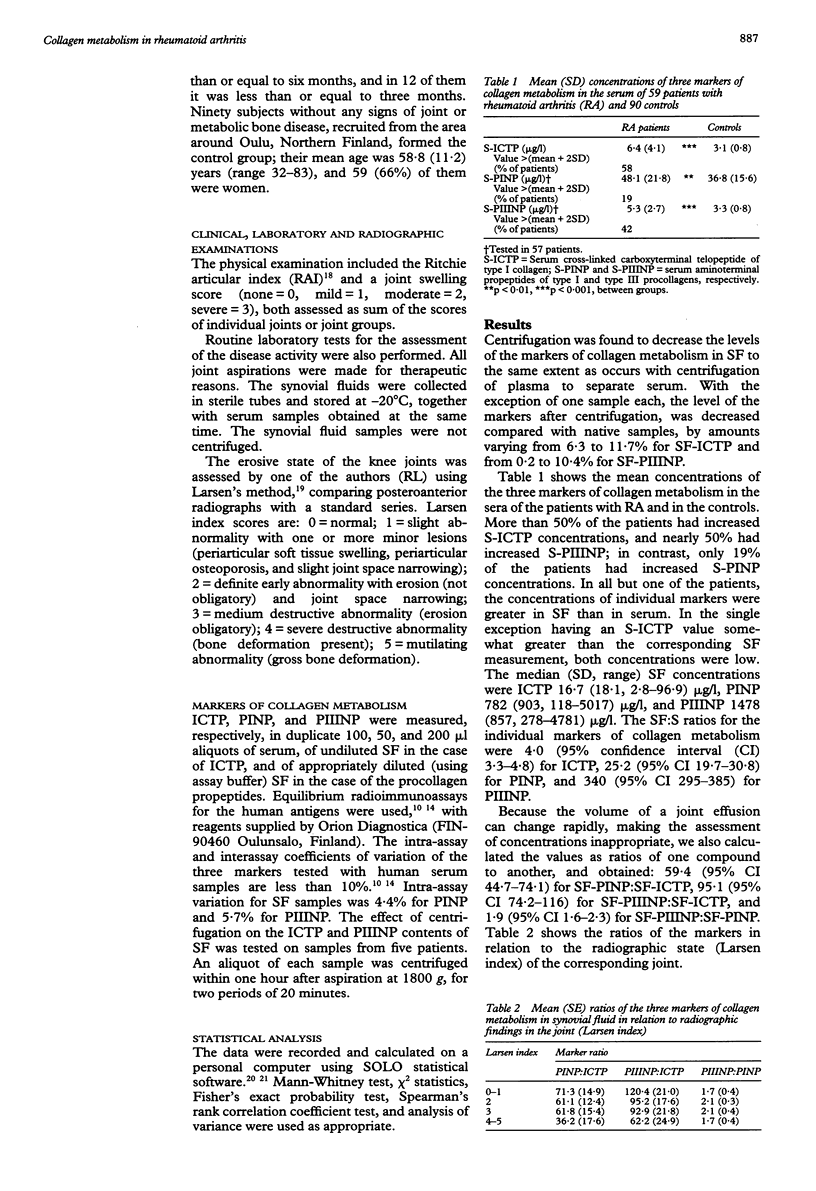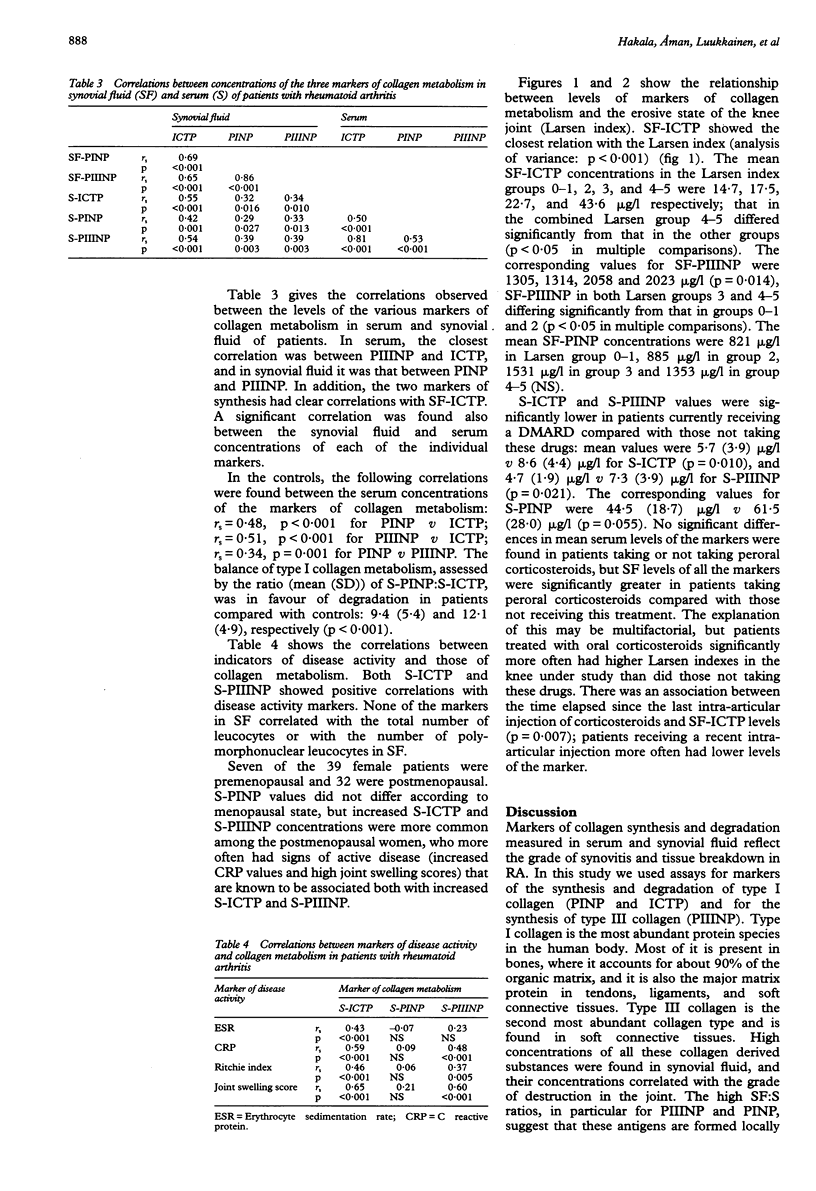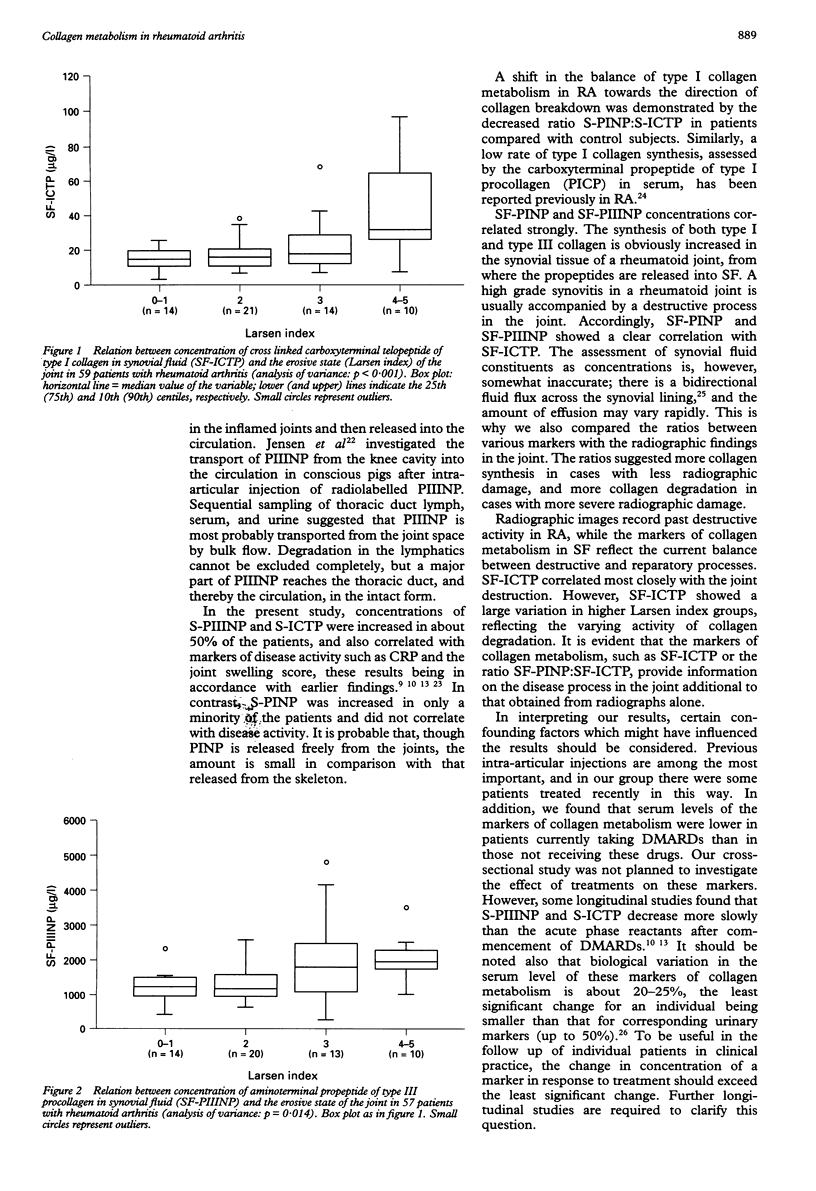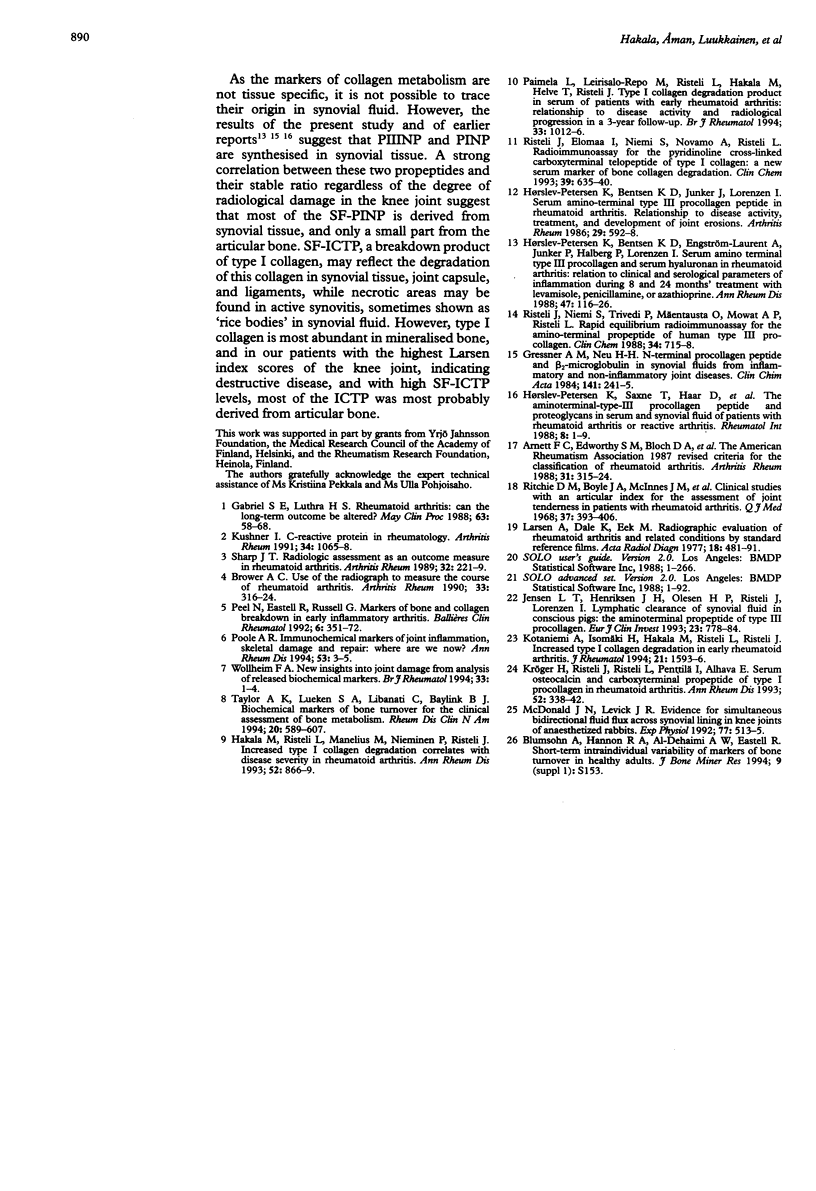Abstract
OBJECTIVE--To assess the potential of markers of collagen metabolism to reflect disease processes in rheumatoid arthritis (RA). METHODS--Serum (S) and synovial fluid (SF) from 59 patients with RA, and a knee joint effusion and serum from 90 control subjects were studied with radioimmunoassays for the aminoterminal propeptides of type I and type III procollagens (PINP and PIIINP, respectively). The breakdown of type I collagen was quantified with a radioimmunoassay for the cross linked carboxyterminal telopeptide of type I collagen (ICTP). RESULTS--About 50% of the patients had increased S-ICTP and S-PIIINP values, whereas S-PINP was increased in only 20% of the patients. The mean SF:S ratios of these markers varied between 4 (for ICTP) and 340 (for PIIINP), indicating that markers of collagen metabolism are formed locally and then released into the circulation. SF-PINP and SF-PIIINP correlated with each other (rs = 0.86, p < 0.001) and with SF-ICTP (rs = 0.69, p < 0.001, and rs = 0.65, p < 0.001, respectively). SF-ICTP was clearly related to radiographic findings in the corresponding knee joint, patients with gross bone deformation having the greatest SF-ICTP concentrations. S-ICTP and S-PIIINP also correlated with conventional markers of disease activity, such as C reactive protein and joint swelling score. CONCLUSION--Markers of collagen metabolism both in serum and synovial fluid can be measured to provide an assessment of disease process in patients with RA. ICTP and PIIINP are the most informative.
Full text
PDF




Selected References
These references are in PubMed. This may not be the complete list of references from this article.
- Arnett F. C., Edworthy S. M., Bloch D. A., McShane D. J., Fries J. F., Cooper N. S., Healey L. A., Kaplan S. R., Liang M. H., Luthra H. S. The American Rheumatism Association 1987 revised criteria for the classification of rheumatoid arthritis. Arthritis Rheum. 1988 Mar;31(3):315–324. doi: 10.1002/art.1780310302. [DOI] [PubMed] [Google Scholar]
- Brower A. C. Use of the radiograph to measure the course of rheumatoid arthritis. The gold standard versus fool's gold. Arthritis Rheum. 1990 Mar;33(3):316–324. doi: 10.1002/art.1780330303. [DOI] [PubMed] [Google Scholar]
- Gabriel S. E., Luthra H. S. Rheumatoid arthritis: can the long-term outcome be altered? Mayo Clin Proc. 1988 Jan;63(1):58–68. doi: 10.1016/s0025-6196(12)62665-2. [DOI] [PubMed] [Google Scholar]
- Gressner A. M., Neu H. H. N-terminal procollagen peptide and beta 2-microglobulin in synovial fluids from inflammatory and non-inflammatory joint diseases. Clin Chim Acta. 1984 Aug 31;141(2-3):241–245. doi: 10.1016/0009-8981(84)90016-0. [DOI] [PubMed] [Google Scholar]
- Hakala M., Risteli L., Manelius J., Nieminen P., Risteli J. Increased type I collagen degradation correlates with disease severity in rheumatoid arthritis. Ann Rheum Dis. 1993 Dec;52(12):866–869. doi: 10.1136/ard.52.12.866. [DOI] [PMC free article] [PubMed] [Google Scholar]
- Hørslev-Petersen K., Bentsen K. D., Engström-Laurent A., Junker P., Halberg P., Lorenzen I. Serum amino terminal type III procollagen peptide and serum hyaluronan in rheumatoid arthritis: relation to clinical and serological parameters of inflammation during 8 and 24 months' treatment with levamisole, penicillamine, or azathioprine. Ann Rheum Dis. 1988 Feb;47(2):116–126. doi: 10.1136/ard.47.2.116. [DOI] [PMC free article] [PubMed] [Google Scholar]
- Hørslev-Petersen K., Bentsen K. D., Junker P., Lorenzen I. Serum amino-terminal type III procollagen peptide in rheumatoid arthritis. Relationship to disease activity, treatment, and development of joint erosions. Arthritis Rheum. 1986 May;29(5):592–599. doi: 10.1002/art.1780290503. [DOI] [PubMed] [Google Scholar]
- Hørslev-Petersen K., Saxne T., Haar D., Thomsen B. S., Bentsen K. D., Junker P., Lorenzen I. The aminoterminal-type-III procollagen peptide and proteoglycans in serum and synovial fluid of patients with rheumatoid arthritis or reactive arthritis. Rheumatol Int. 1988;8(1):1–9. doi: 10.1007/BF00541343. [DOI] [PubMed] [Google Scholar]
- Jensen L. T., Henriksen J. H., Olesen H. P., Risteli J., Lorenzen I. Lymphatic clearance of synovial fluid in conscious pigs: the aminoterminal propeptide of type III procollagen. Eur J Clin Invest. 1993 Dec;23(12):778–784. doi: 10.1111/j.1365-2362.1993.tb00731.x. [DOI] [PubMed] [Google Scholar]
- Kotaniemi A., Isomäki H., Hakala M., Risteli L., Risteli J. Increased type I collagen degradation in early rheumatoid arthritis. J Rheumatol. 1994 Sep;21(9):1593–1596. [PubMed] [Google Scholar]
- Kröger H., Risteli J., Risteli L., Penttilä I., Alhava E. Serum osteocalcin and carboxyterminal propeptide of type I procollagen in rheumatoid arthritis. Ann Rheum Dis. 1993 May;52(5):338–342. doi: 10.1136/ard.52.5.338. [DOI] [PMC free article] [PubMed] [Google Scholar]
- Kushner I. C-reactive protein in rheumatology. Arthritis Rheum. 1991 Aug;34(8):1065–1068. doi: 10.1002/art.1780340819. [DOI] [PubMed] [Google Scholar]
- Larsen A., Dale K., Eek M. Radiographic evaluation of rheumatoid arthritis and related conditions by standard reference films. Acta Radiol Diagn (Stockh) 1977 Jul;18(4):481–491. doi: 10.1177/028418517701800415. [DOI] [PubMed] [Google Scholar]
- McDonald J. N., Levick J. R. Evidence for simultaneous bidirectional fluid flux across synovial lining in knee joints of anaesthetized rabbits. Exp Physiol. 1992 May;77(3):513–515. doi: 10.1113/expphysiol.1992.sp003613. [DOI] [PubMed] [Google Scholar]
- Paimela L., Leirisalo-Repo M., Risteli L., Hakala M., Helve T., Risteli J. Type I collagen degradation product in serum of patients with early rheumatoid arthritis: relationship to disease activity and radiological progression in a 3-year follow-up. Br J Rheumatol. 1994 Nov;33(11):1012–1016. doi: 10.1093/rheumatology/33.11.1012. [DOI] [PubMed] [Google Scholar]
- Peel N., Eastell R., Russell G. Markers of bone and collagen breakdown in early inflammatory arthritis. Baillieres Clin Rheumatol. 1992 Jun;6(2):351–372. doi: 10.1016/s0950-3579(05)80179-7. [DOI] [PubMed] [Google Scholar]
- Poole A. R. Immunochemical markers of joint inflammation, skeletal damage and repair: where are we now? Ann Rheum Dis. 1994 Jan;53(1):3–5. doi: 10.1136/ard.53.1.3. [DOI] [PMC free article] [PubMed] [Google Scholar]
- Risteli J., Elomaa I., Niemi S., Novamo A., Risteli L. Radioimmunoassay for the pyridinoline cross-linked carboxy-terminal telopeptide of type I collagen: a new serum marker of bone collagen degradation. Clin Chem. 1993 Apr;39(4):635–640. [PubMed] [Google Scholar]
- Risteli J., Niemi S., Trivedi P., Mäentausta O., Mowat A. P., Risteli L. Rapid equilibrium radioimmunoassay for the amino-terminal propeptide of human type III procollagen. Clin Chem. 1988 Apr;34(4):715–718. [PubMed] [Google Scholar]
- Ritchie D. M., Boyle J. A., McInnes J. M., Jasani M. K., Dalakos T. G., Grieveson P., Buchanan W. W. Clinical studies with an articular index for the assessment of joint tenderness in patients with rheumatoid arthritis. Q J Med. 1968 Jul;37(147):393–406. [PubMed] [Google Scholar]
- Sharp J. T. Radiologic assessment as an outcome measure in rheumatoid arthritis. Arthritis Rheum. 1989 Feb;32(2):221–229. doi: 10.1002/anr.1780320218. [DOI] [PubMed] [Google Scholar]
- Taylor A. K., Lueken S. A., Libanati C., Baylink D. J. Biochemical markers of bone turnover for the clinical assessment of bone metabolism. Rheum Dis Clin North Am. 1994 Aug;20(3):589–607. [PubMed] [Google Scholar]


